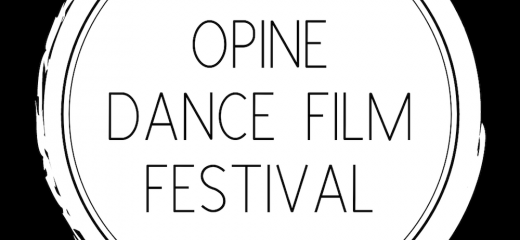
Made for the Screen: Opine Dance Film Festival
by Kalila Kingsford Smith
A German tap company jumps between a colorfully-tiled dance hall and graffitied tunnels, the flow of movement punctuated with the rhythms of their feet and the edits of the film. A quartet of men from Zimbabwe lift each other in the desert, a voice-over questioning what it means to “become a man.” A girl in the UK discovers an abandoned schoolhouse and swirls in the empty room, etching circles into the wooden floor with her toenails. Watching Opine Dance Film Festival, I am drawn in by the unseen dance partner: the camera. It directs my eyes to details of the body as it circles the dancers and follows them through sites unknown. The craftsmanship of the directors and choreographers captivates me. Not only do they choreograph the human body, but also the camera frame and the transitions between shots. These are not dances documented on camera, like those currently streamed to audiences in the absence of live performance. These are dances made for consumption on the screen.
Interested in talking with someone experienced in digital dance as so much of the field moves online, I called Britt Whitmoyer Fishel*, founder and co-curator of Opine Dance Film Festival. Fishel has worked in the field of digital dance for twelve years. The festival, set to open in person in late-March, was moved online due to COVID-19.

Photo: POGO, by Andres Aguirre
Kalila Kingsford Smith: Tell me a bit about your process curating a screendance festival.
Britt Whitmoyer Fishel: This is Opine Dance Film Festival’s fifth year, and I worked with two other curators to generate the season. In the first couple of years, I did it on my own, on a much smaller scale. Then as it grew, I realized that I should not be the sole curator of these films. I consistently curate with Maxx Passion. She has a great eye and does a great job of challenging any bias that I may subconsciously have. She has a different film aesthetic from me, which is important in the curation process. This season, I also had Lydia Patselas on our curatorial team. She’s an emerging dance artist, but because she is younger, she has a fresh eye.
This season, we had 208 submissions and we selected 34 films. We originally had 35, but once we moved onto the online platform, one filmmaker was uncomfortable having their online premiere with us. You have to respect any guidelines for what [the filmmaker’s] preference is for [their films] being shown. Once we moved to the online platform, the response from the other artists was overwhelmingly positive. Many people were excited that we had taken the time to figure out an alternative method to be able to support the work they were making.
KKS: What do you look for in your curation process?
BWF: We prioritize both inclusion and diversity, so we look at where these films come from. We also look at the quality and craftsmanship of the work and the film—not just the choreography and the bodies in space, but also the capture of the film and the editing styles. We look at how they go hand-in-hand in making that body leap off a two-dimensional space and connect with the eyes of the audience. That can come down to smooth [editing] transitions, colorization, timing, the rhythm of the edit, the use of music or lack thereof, the landscape of the body on camera, and what “dance on camera” actually means.
We are also excited by films that have an arc to them. We don’t prioritize narrative stories, but we do like when the point of the film transcends. It doesn’t have to be literal storytelling; it can be experimental and abstract.
Then we look at the program as a whole. Can we see this film fitting in with this line-up and meshing with the stylization of this season? Screendance is developing and growing every year, so it changes the way the program looks.
KKS: That also seems true in terms of how technology changes. The ways of engaging with it are constantly shifting.
BWF: It has become this widely accessible tool that everyone is excited to play with. But the more you experiment, the more you educate yourself and the higher the skill level becomes, which makes [the field] more competitive. I have seen such an elevation of the quality of work in the last five years.
KKS: Can you describe the shift you had to make to accommodate the cancellation of the live event?
BWF: Originally, [Opine Dance Film Festival] was going to be shown at Carpenter Library on Bryn Mawr College’s campus. There were going to be three large monitors playing each program (two professional and one student) on a loop system. I made banners with program information that would hang on the walls gallery-style. They would have been on a loop all day March 20th and 21st. Because it was a free program, an audience member could sit for ten minutes, or they could sit there for an hour. They could come and go.
Streaming it online had a completely different effect, and part of me feels that there is a silver lining. The professional program had over 500 views, which would not have been the case in the gallery space. Now, I don’t know if 500 people watched every single film, but I had several people from all over the country, all over the world, thanking me. Even the filmmakers—many of whom are international—were just so thrilled to see the program they were involved with.
KKS: Would you do it like this again? Or would you have to change the model?
BWF: I would have to do a survey with the current filmmakers to ask, “If this wasn’t our current circumstance, would you still approve of the festival taking place online versus being somewhere brick and mortar?” A lot of [filmmakers] don’t love submitting films for an online festival because they don’t yet want their film premiered online. They tour it for in-person film festivals where you go and sit [to watch], or you go to a gallery.
However, I feel I reached people I wouldn’t have been able to otherwise. It also requires less technological set-up. I just want to make sure that I keep the integrity of the filmmakers in mind.
KKS: As a newcomer to the screendance world, I am curious about its touring culture. Is it typical to only have it shown in live festivals? What benefit does that provide the screendancer?
BWF: There is a culture. Once you finish producing a film—especially if you have a true budget and a team that you’ve worked with—you want to start touring, the same way that you would tour a live work, through a festival circuit. The circuit is any sort of dance-specific film festival. It could be that you do that for one season or you do it over a span of three years. After that, you may say, “Ok, we are going to be in control of our online premiere of this.”
KKS: And perhaps creating ticket revenue through this online premiere?
BWF: Potentially. A lot of people on Vimeo are moving to a program called “On Demand.” So if I moved my films to an On Demand setting, people could pay five dollars and watch the series of films that I have.
KKS: I could imagine that this also has to do with copyright and authorship in digital space.
BWF: Absolutely. Even when we had it online, we kept the original dates of the film festival and took it down after. So many people were asking why it wasn’t online anymore, thinking they had public access to it. That’s the difference with the internet; people expect that they can view these dances forever.
KKS: Given that the dance world has shifted online overnight, what does it change or challenge about screendance?
BWF: It has been interesting to look at the comfortability that our community has with the digital space, pre-coronavirus versus now. So many people have argued against [putting dance online] for so long. Now that we are being forced to use it, many are scrambling, and many need help. In that way, I am thankful that I am deep into technology and the digital world with dance. I can immerse myself and help people who need assistance during this time.
I have observed that many people decided to make a screendance now. I myself am considering that for a show that was cancelled in May, but I also work in the world of screendance, whereas a lot of people are just starting out. I encourage everyone to make screendances and to experiment and explore, but I do want everyone to understand that it can be more complicated than, "Let me turn on my phone and shoot it." Screendance is a technique. I really hope that, out of all of this, we will grow as a community to become more comfortable with digital space in dance. I do feel slightly protective over it.
I’m noticing a resurgence, an awakening of people paying attention to screendance now, which I’m grateful for. I’m happy that there is attention drawn to finding new ways of using digital space. There really is a silver lining in this precarious time of uncertainty.
If you are interested in exploring the realm of screendance in more depth, Fishel recommends The Screendance Collective on Vimeo, which has an archive of screendances from the ’90s to 2019.
Opine Dance Film Festival, March 20-21. Interview with Britt Whitmoyer Fishel, March 28.
*Fishel and Kingsford Smith are both adjunct faculty members at Drexel University and graduates of the University of Michigan.
By Kalila Kingsford Smith
April 17, 2020







